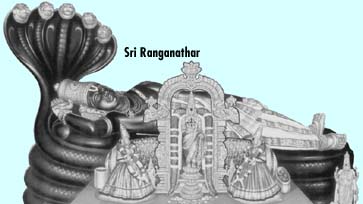 |
 20th June 1999 |
Front Page| |
Point of viewSri Rangam Vishnu Temple and its significance to us
On the other hand, there seems to be some gaps in the information provided about the Vishnu Temple at Trichirappalli in South India which is historically known as Sri Rangam Temple and its southward gopuram which is believed to be emanating a malefic influence on Sri Lanka. The purpose of this article is to fill these gaps with information coming down to our times through sacred scriptures, historical accounts and age old tradition and present a complete story so that the public will have a clearer picture and a better understanding of the significance of Sri Rangam Temple to us in Sri Lanka. It may be of interest to mention that the story of the Sri Rangam Temple begins at the time Lord Ramachandra, fought and killed Ravana, the demon King of Lanka who had kidnapped Sitadevi, the consort of Lord Ramachandra. Lord Ramachandra after his victory made Vibhisana, the brother of Ravana, the King of Lanka. Vibhisana, the newly enthroned King asked for and received, an extraordinary gift- Sri Ranga Vimana, -image of Lord Vishnu-from Lord Ramachandra which had been worshipped not only by Lord Ramachandra but also by others from time immemorial. The scriptures say that Sri Ranga Vimana had originally been gifted to Lord Brahma by Lord Vishnu, and Lord Brahma in turn had given it to the Sun God who in turn had given it to Manu, the father of mankind. Manu in turn gave it to King Ikshvaku in whose dynasty Lord Ramachandra has appeared. Vibhisana was keen to have Sri Ranga Vimana as he firmly believed that the deity would bring peace and prosperity to Lanka. Unfortunately he could not bring the deity to Lanka, as he had violated the instructions given by Lord Ramachandra that he should not place the deity on the ground. Vibhisana had inadvertently placed the Sri Ranga Vimana on the ground at a spot near the river Kaveri and Sri Ranga Vimana became firmly rooted at this place. When Vibhisana tried to continue his journey, Lord Ranganatha would not move. Lord Ranganatha blessed Vibhisana promising to always look toward Vibhisana's kingdom, Lanka. Although most deities in India face east, Sri Ranganatha Swami reclines on His right side with His head towards the west as He looks south toward His great devotee Vibhisana. And this was the spot where Sri Rangam temple, the oldest and the largest Vishnu Temple in India came to be established. The Temple has 22 gopurams in all directions, leaving the one in the southern side incomplete. Many Kings and devotees had tried to complete the construction of the southern gopuram but every time the construction was started, it is said to have failed and fallen to pieces. Centuries later, in 1979, a saint by the name Srimath H.H. Jeer Swamigal of Ahobila Mutt who visited this place on pilgrimage had divine directions to complete the southern gopuram, facing Sri Lanka. The construction work started immediately while the saint was performing austerities and penance and took seven years to complete. This gopuram was ceremonially opened in 1987 with the participation of M.G. Ramachandran, the then Chief Minister of Tamil Nadu. At this point, it would be appropriate to review briefly some of the well established popular beliefs that are in vogue in South India and Sri Lanka concerning the influence of Sri Rangam Temple on Sri Lanka. The first among them is the belief that a stone inscription belonging to the 13th century foretells that the destruction in Lanka will begin once the construction of the southern gopuram is complete. When one devotee from Sri Lanka known to me asked Saint Srimath H.H. Jeer Swamigal of Ahobila Mutt in 1987 who successfuly completed the Southern gopuram, about the calamities in Sri Lanka, he said the calamities in the island would end when one Vishnu Temple with gopuram in the style of Sri Rangam Temple is built in Sri Lanka and the temple worship is practised according to pancharatra system. This system of worship came down from Lord Brahma. The proposed Vishnu Temple would, we believe, develop as an inter- religious centre of worship, a spiritual centre where different cultures find harmonious intermingling. History shows that the people in the world have realised the impact of forces which are beyond the capacity of human understanding. Should we hasten to reject as mere superstition, things that are incomprehensible to our material senses? This kind of project, in our view, is a commendable effort which deserves the backing of our leaders, political, religious, academic and business as well as the general public. Mahakarta Das, |
||
 |
Front Page| News/Comment| Editorial/Opinion| Business| Sports | Mirror Magazine |
|
 |
Please send your comments and suggestions on this web site to |
|
 News
of the project to set up a Vishnu temple in Muthurajawela published in
the Sunday Times of June 6, has aroused a great deal of interest among
scholars, religious dignitaries and businessmen. The views and opinions
expressed quite naturally, were of divergent character, some in favour
and yet others severely critical.
News
of the project to set up a Vishnu temple in Muthurajawela published in
the Sunday Times of June 6, has aroused a great deal of interest among
scholars, religious dignitaries and businessmen. The views and opinions
expressed quite naturally, were of divergent character, some in favour
and yet others severely critical.